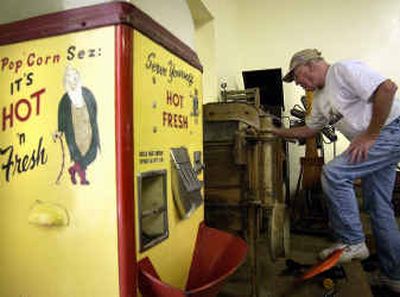Valley’s history will live on

Commuters using the Spokane Valley’s first bus service used to sit in wicker chairs placed on the back of a flatbed truck to get to and from work. Residents sometimes took dance lessons and watched silent movies in the old Opportunity Township Hall. And children marveled over the rocket-ship ride at Natatorium Park, the area’s early version of a theme park.
The people who lived those bits of the Spokane Valley’s history eventually will fade away, but thanks to a new museum local history will live on.
After three years in the making, the Spokane Valley Heritage Center is ready to hold an open house Friday. A grand opening, where attendees will be encouraged to dress 1920s style, is scheduled for Oct. 15. The center, at 12114 E. Sprague Ave., will hold regular daytime hours after the second event.
“In one sense, we’ve already been open,” said Jayne Singleton, the museum’s coordinator, referring to the countless residents who have popped into the museum since the nonprofit took ownership of Opportunity Township Hall in February. They come with artifacts, questions and memories.
Debbie and Al Shrock came wanting to know how their street, Mamer Road, got its name. Singleton told them about Nick Mamer, one of the first pilots for Northwest Airlines.
Hooked, the Shrocks began volunteering with the museum. Monday, they were busy cleaning the building.
A core group of volunteers have built the museum from scratch. They are Singleton, Chuck King, Mary Jane Honneger, Clark Bainbridge, Lois Cunningham, Don Gorman, Bill Crawford, Herb Welch, Jerry Turner, the Shrocks, and, on an advisory basis, Valley author Florence Boutwell.
Often, as the crew is working, Cunningham sneaks into the museum kitchen and cooks dinner. The group gathers at a fold-out table, Al Shrock says a prayer and they eat together like a family. That’s when some of the best ideas for the museum are born and where they exchange tips on where to find more artifacts, Singleton said.
“We talk about what we’re going to do next,” she said. “Someone will say, ‘I ran into so and so.’ “
Some of the museum’s displays aren’t Valley specific. A rusty crib from the 1890s with a hidden compartment for diapers simply will give museum-goers an idea of how parents coped before Baby Bjorns and Diaper Genies were invented.
Other museum items have Valley written all over them. A wooden machine that cleaned apples at the Van Hees Orchards. Photos of Felts Field, one of the country’s oldest airports. A sign from Behm’s Valley Creamery, a long-time local business.
Although the museum is new, it has an accomplishment some established museums would envy. It recently landed an exhibit from the Smithsonian Institute’s “Museum on Main Street” series.
“Between Fences,” an exhibit about the role of fences in American culture, will travel to the Spokane Valley Heritage Center in March of 2006.
“It’s quite a feather in the cap for a museum whose doors aren’t even open,” Singleton said.
The museum is one of only six in Washington state that will host the exhibit.
“I felt (the theme) would particularly resonate with the residents here in the Valley,” she said.